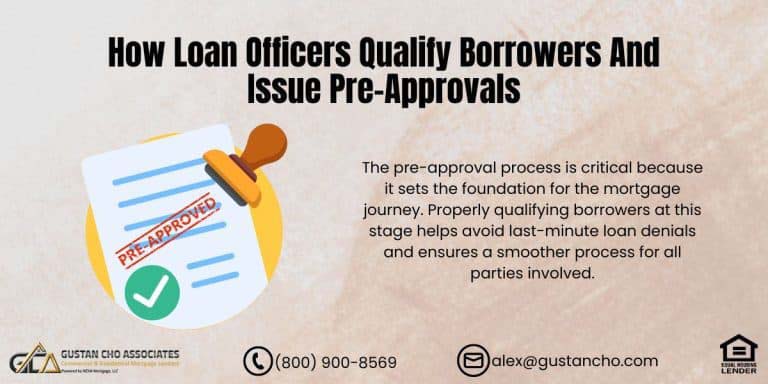Mortgage Approval Process on Manual Underwriting: A Comprehensive Guide for 2024
The mortgage approval process can be overwhelming, especially with manual underwriting involved. Unlike automated underwriting, which relies on algorithms, manual underwriting involves a human underwriter meticulously reviewing your financial history and documents. This guide aims to demystify the mortgage approval process on manual underwriting for 2024, including updated steps, requirements, and real-life examples.
Understanding Manual Underwriting
When you’re trying to get a loan, especially for a home, there’s something known as the mortgage approval process on manual underwriting that you might go through. This happens when the usual quick, computerized check can’t say “yes” to your loan application.
Manual underwriting is especially common for FHA and VA loans, which are specific types of loans. Still, it’s not something you’ll often see with conventional loans (the standard loans people usually get).
So, what is this mortgage approval process on manual underwriting all about? It’s basically a very detailed check-up on how you manage your money. The goal here is to make sure you can truly afford to take on the loan and pay it back over time. Think of it as someone going through your financial life with a fine-tooth comb, checking out everything from how much you earn and how you spend your money to other debts you might have.
By going through the mortgage approval process on manual underwriting, the lender is doing their homework to see if lending you money makes sense. They want to feel confident that you won’t have trouble making your loan payments down the line. So, if you’re going this route, be prepared to share a lot of information about your finances, but know it’s all part of ensuring your loan fits within your budget and doesn’t lead to stress later on.
Struggling to Get Approved? Let’s Navigate the Manual Underwriting Process Together!
Contact us today to learn how we can assist you in securing mortgage approval through manual underwriting.
Steps in the Mortgage Approval Process on Manual Underwriting
- Initial Application: Begin by submitting your mortgage application, including all required documents like income proof, credit history, and employment details.
- Automated Underwriting System (AUS) Check: Your application will first go through an Automated Underwriting System (AUS). If the AUS renders a “refer/eligible” decision, your application will move to manual underwriting.
- Document Collection: Gather and submit additional documentation that the manual underwriter may request. This can include bank statements, tax returns, and explanations for any credit issues.
- Detailed Review: The manual underwriter reviews your entire financial profile, considering compensating factors that an automated system might need to evaluate adequately.
- Decision and Conditions: Based on the review, the underwriter will approve, deny, or conditionally approve your loan. You may need to provide more information or meet specific criteria if conditionally approved.
- Final Approval: Once all requirements are met, the loan is approved, and you can close.
Requirements and Documentation Needed
Navigating through the mortgage approval process on manual underwriting can seem daunting, but knowing exactly what documents you need can streamline the whole experience. Unlike the automated route, the mortgage approval process on manual underwriting takes a closer, more detailed look at your financial background, requiring plenty of paperwork:
- Income Verification: This is where your pay slips, W-2 forms, and tax returns for the last two years come into play. It’s all about proving you have a steady income to cover your mortgage payments.
- Where You Work Matters: They’ll want a verification of employment (VOE) straight from your employer. It’s their way of making sure you work where you say you do.
- The Credit Report Chronicles: Your credit history is an open book in this process. Even if you’ve had a few missteps in the past, it’s not a deal-breaker. The key is showing that you’ve gotten back on track with your payments.
- Show Me the Money: Your bank statements and any other assets you’ve got need to be on display. These act as a safety net, proving you have reserves to fall back on.
- Storytime: Any negative marks on your credit report? You’ll need to draft up some letters explaining each situation. Think of it as setting the record straight.
Specific Criteria and Guidelines
When it comes to the specific criteria and guidelines that drive the mortgage approval process on manual underwriting, things get a bit more meticulous:
- The Balancing Act of Debt-to-Income (DTI) Ratio: This is typically kept under 50% for FHA and VA loans. But, if you’ve got some ace cards like strong residual income or a hefty chunk of savings, it may sway things in your favor.
- Credit Score Check: The magic number for FHA loans is at least 580, but there’s no hard-set minimum for VA loans, even though lenders tend to look for scores of 620 or above.
- Compensating Factors: These could be your saving grace, things like having a stable job for years, a healthy savings account, or little to no monthly debt.
Talking about the mortgage approval process on manual underwriting in everyday terms helps peel back the curtain on what can otherwise seem mysterious and complicated. Remember, it’s all about showing lenders that you’re a safe bet to take on a mortgage.
Comparison Between Manual and Automated Underwriting
When comparing the traditional way of checking your info for a loan (manual underwriting) with the computerized method (automated underwriting), it’s mainly about how closely someone or something is looking at your details and how flexible they can be. Automated underwriting is quick because it follows strict rules through computer programs.
On the other hand, manual underwriting brings a personal touch, with real people looking over your loan application. This can be helpful for folks who have unique money situations that need to fit neatly into a computer’s checklist.
Talking about the mortgage approval process on manual underwriting, here’s what stands out:
Pros of manual underwriting:
– Flexibility is a big win here. People checking your loan application can give you some slack if there are other good signs that you can repay the loan, something a computer can’t do.
– You get a more human look at your financial past. A real person can understand your situation better than a computer.
Cons:
– The mortgage approval process on manual underwriting can take a lot of work. Because someone is going through your info piece by piece, it takes longer to get an answer.
– You might find the rules stricter, and you might need to meet higher standards because there’s more attention to detail.
So, if you’re going through the mortgage approval process on manual underwriting, it’s like having a teacher grade your paper with a red pen, taking their time and considering everything, versus a quick computer scan that looks for right or wrong answers.
Need Mortgage Approval Through Manual Underwriting? We’re Here to Help!
Reach out now to discuss how manual underwriting can work for you and get started on your mortgage approval process.
Tips for Improving Your Chances of Approval
When seeking mortgage approval through manual underwriting, a few smart moves can significantly increase your likelihood of success. These strategies are all about showing that you’re responsible with money and ready for the commitment of a mortgage. Remember, manual underwriting lets a person, not a computer, review your financial situation. So, you’ll want to put your best foot forward.
Maintain Timely Payments
First, always pay your bills and any loans you have on time. This is super important, especially in the year before you apply for a mortgage. Staying on top of your payments shows you’re reliable and manage your money well. It’s a big thumbs up in the mortgage approval process on manual underwriting.
Reduce Debt
Next, think about your debt. Lowering how much you owe is smart because it improves your debt-to-income ratio. This ratio is a way of saying how your debt stacks up against what you make. A lower ratio is better because it shows you’re not over your head in debt.
Increase Savings
Having more money in your savings is also a great idea. When lenders see you’ve got a good chunk of change tucked away, it reassures them. It’s like having a safety net, which helps during the mortgage approval process on manual underwriting.
Provide Thorough Documentation
Another key step is being organized and ready with all your paperwork. Have all the documents you need for your application, and be ready to provide any extra info if they ask. This can speed things up and show you’re serious about the process.
Work with Experienced Lenders
Lastly, choosing the right lender is crucial. Make sure to partner with an individual who is well-versed in the details of manual underwriting. For example, Gustan Cho Associates is a pro at this. They understand all the little details and can help you increase your chances of getting approved.
Focusing on these areas can really improve your odds in the mortgage approval process based on manual underwriting. It’s about demonstrating that you’re a solid bet and can handle a mortgage responsibly.
Real-Life Success in the Mortgage Approval Process on Manual Underwriting
Navigating Through Credit Hurdles
Imagine being Mark, a dedicated veteran, venturing into the homebuying journey, dreaming of securing a place to call his own. Initially, he hit a snag in the traditional mortgage approval process due to past credit issues. The phrase “manual underwriting” might sound daunting to many, but it was a beacon of hope for Mark.
Unlike the automated rejection he faced due to a less-than-perfect credit score, manual underwriting provided a personalized review of his application.
Mark had a steady job, a commendable amount of savings tucked away, and a flawless record of paying rent on time. These strengths were his compensating factors, shining brightly under the manual underwriter’s scrutiny. Mark’s loan received the green light thanks to the tailored approach of the mortgage approval process on manual underwriting. This victory meant more than just numbers on paper; it was his first step into homeownership, a dream come true for our brave veteran.
Tackling the High Debt-to-Income Challenge
Let’s shift our focus to Denise, a hopeful homebuyer aiming for a home under the FHA program. The term “high DTI ratio” was the barrier between her and her dream home. However, the mortgage approval process on manual underwriting opened up a new path for her.
Denise had a unique financial profile; despite her high debt-to-income (DTI) ratio, she boasted strong residual income and had minimal monthly financial obligations.
In the eyes of the manual underwriter, these were significant compensating factors, indicating that Denise had more than enough breathing room in her budget to manage a mortgage payment. The mortgage approval process on manual underwriting was designed to catch these nuances, providing a platform where Denise’s financial strengths were fully recognized and appreciated.
Consequently, her application was approved, marking a significant milestone in her life. She was now on her way to becoming a homeowner, proving that a high DTI ratio doesn’t always spell the end of one’s homebuying aspirations.
These stories reveal the personal and accommodating nature of the Mortgage Approval Process on Manual Underwriting. By focusing on the individual’s entire financial picture rather than just a credit score or DTI ratio, John and Maria overcame their unique challenges. This process underscores the importance of considering a borrower’s full story, highlighting how manual underwriting can indeed pave the way for deserving individuals to achieve their homeownership dreams.
Conclusion
The mortgage approval process on manual underwriting may seem rigorous, but it offers a valuable alternative for borrowers with unique financial situations. You can navigate this process more confidently by understanding the steps, requirements, and strategies to improve your chances. Whether it’s managing debt, increasing savings, or working with the right lender, being well-prepared can lead to a successful mortgage approval.
Gustan Cho Associates is a reliable partner for those seeking expertise in manual underwriting. They have extensive experience handling manual underwriting for FHA and VA loans, ensuring borrowers receive personalized and thorough evaluations. Contact them at 800-900-8569 or gcho@gustancho.com for more information and assistance.
Remember, achieving your homeownership dreams is within reach with the right preparation and understanding of the mortgage approval process on manual underwriting.
FAQs: Mortgage Approval Process On Manual Underwriting
- 1. What is the mortgage approval process on manual underwriting? The mortgage approval process, which involves manual underwriting, involves a human underwriter meticulously reviewing your financial history and documents instead of relying on an automated system. This detailed process is used when the automated system cannot approve your loan, and it is common for FHA and VA loans.
- 2. Why would my mortgage application go through manual underwriting? Your application might undergo manual underwriting if the Automated Underwriting System (AUS) cannot approve it. This often happens if your financial profile has unique factors that need a more personalized review.
- 3. What are the steps in the mortgage approval process on manual underwriting? The mortgage approval process on manual underwriting begins with submitting your application and required documents. If the Automated Underwriting System (AUS) returns a “refer/eligible” decision, your application moves to manual underwriting. As requested, you’ll provide additional documentation, and the underwriter will conduct a detailed review of your financial profile. Based on this review, the underwriter will approve, deny, or conditionally approve your loan. Final approval is granted once all conditions are met.
- 4. What documents do I need for the mortgage approval process on manual underwriting? For manual underwriting mortgage approval, you’ll need income verification (pay stubs, W-2s, tax returns), employment verification (VOE), credit reports, bank statements, and explanation letters for derogatory marks.
- 5. What criteria and guidelines are used in manual underwriting? The Debt-to-Income (DTI) Ratio is typically capped at 50% for FHA and VA loans in manual underwriting. For FHA loans, a credit score of at least 580 is needed, and for VA loans, a score of 620 or above is typically required. Compensating factors like stable employment history and minimal monthly debt are also considered.
- 6. How does manual underwriting compare to automated underwriting? Manual underwriting offers a more flexible and personalized assessment of your financial situation, considering various compensating factors. Unlike automated underwriting, which depends on algorithms and preset criteria, manual underwriting involves a detailed review by a human underwriter.
- 7. How can I improve my chances of mortgage approval through manual underwriting? To improve your chances of mortgage approval through manual underwriting, focus on maintaining timely payments, reducing overall debt, increasing savings, providing thorough documentation, and working with experienced lenders like Gustan Cho Associates.
- 8. Can you provide examples of successful mortgage approvals through manual underwriting? There are instances where successful mortgage approvals have been achieved through manual underwriting. For example, John, a veteran who had faced credit issues in the past, was approved for a VA loan. His stable employment, considerable savings, and solid rental history played a crucial role in his approval. Another case involves Maria, who managed to secure an FHA loan despite having a high DTI ratio. Her strong residual income and minimal monthly expenses were key to her loan approval.
- 9. Are there specific lenders who specialize in manual underwriting? Yes, lenders like Gustan Cho Associates specialize in manual underwriting for FHA and VA loans. They understand the detailed requirements and can help you through the process.
- 10. How can I contact Gustan Cho Associates for more information? You can reach Gustan Cho Associates at 800-900-8569 or email them at gcho@gustancho.com. They are available to assist you with your mortgage needs and provide guidance through the mortgage approval process on manual underwriting.
Understanding the mortgage approval process on manual underwriting and preparing thoroughly can significantly enhance your chances of securing a mortgage, even if you have a unique financial situation.
This blog about the Mortgage Approval Process On Manual Underwriting was updated on July 9th, 2024.
Ready to Apply for a Mortgage with Manual Underwriting? Let’s Make It Happen!
Contact us today to see how we can help you get approved and move forward with your home purchase.










